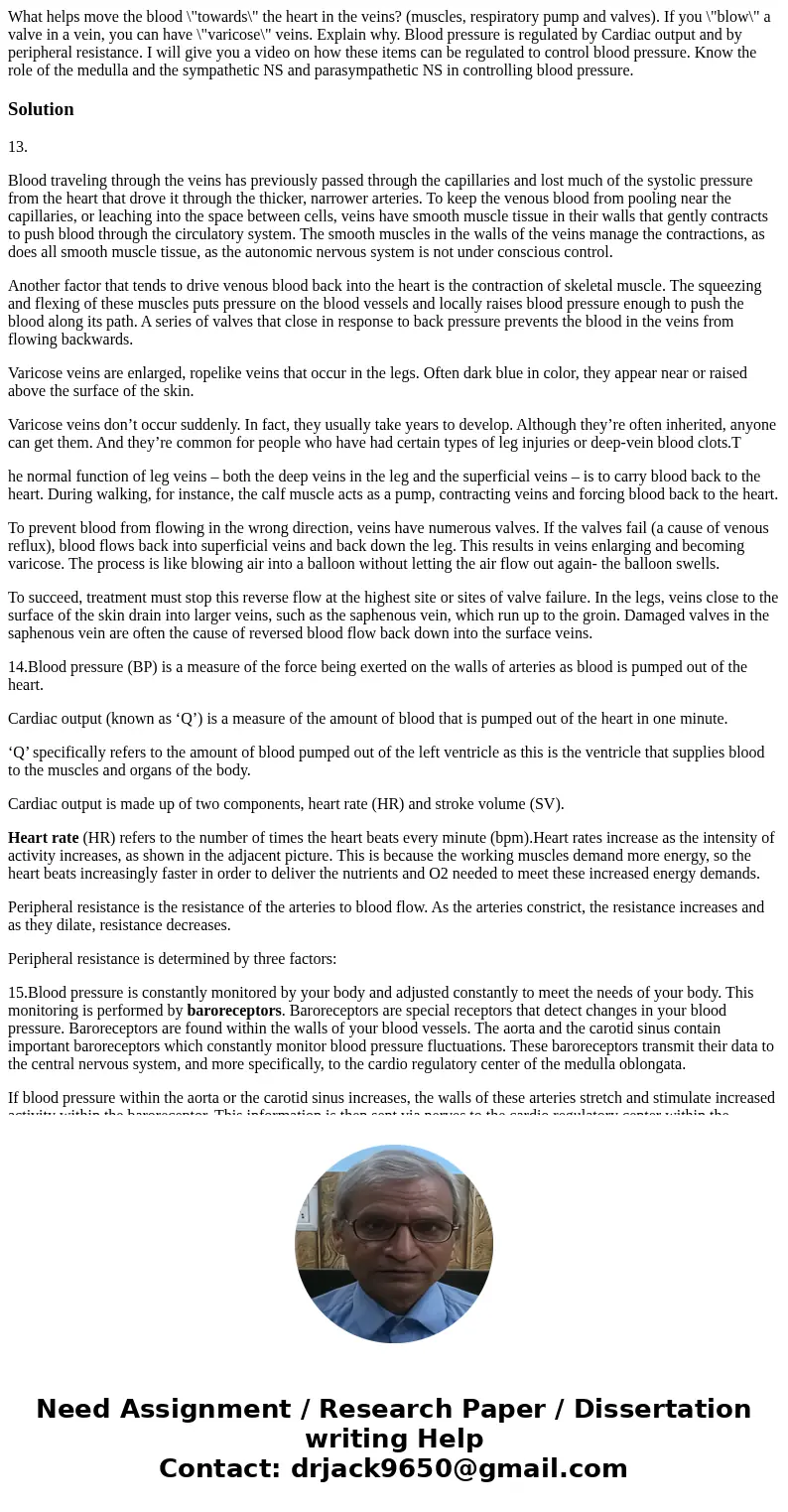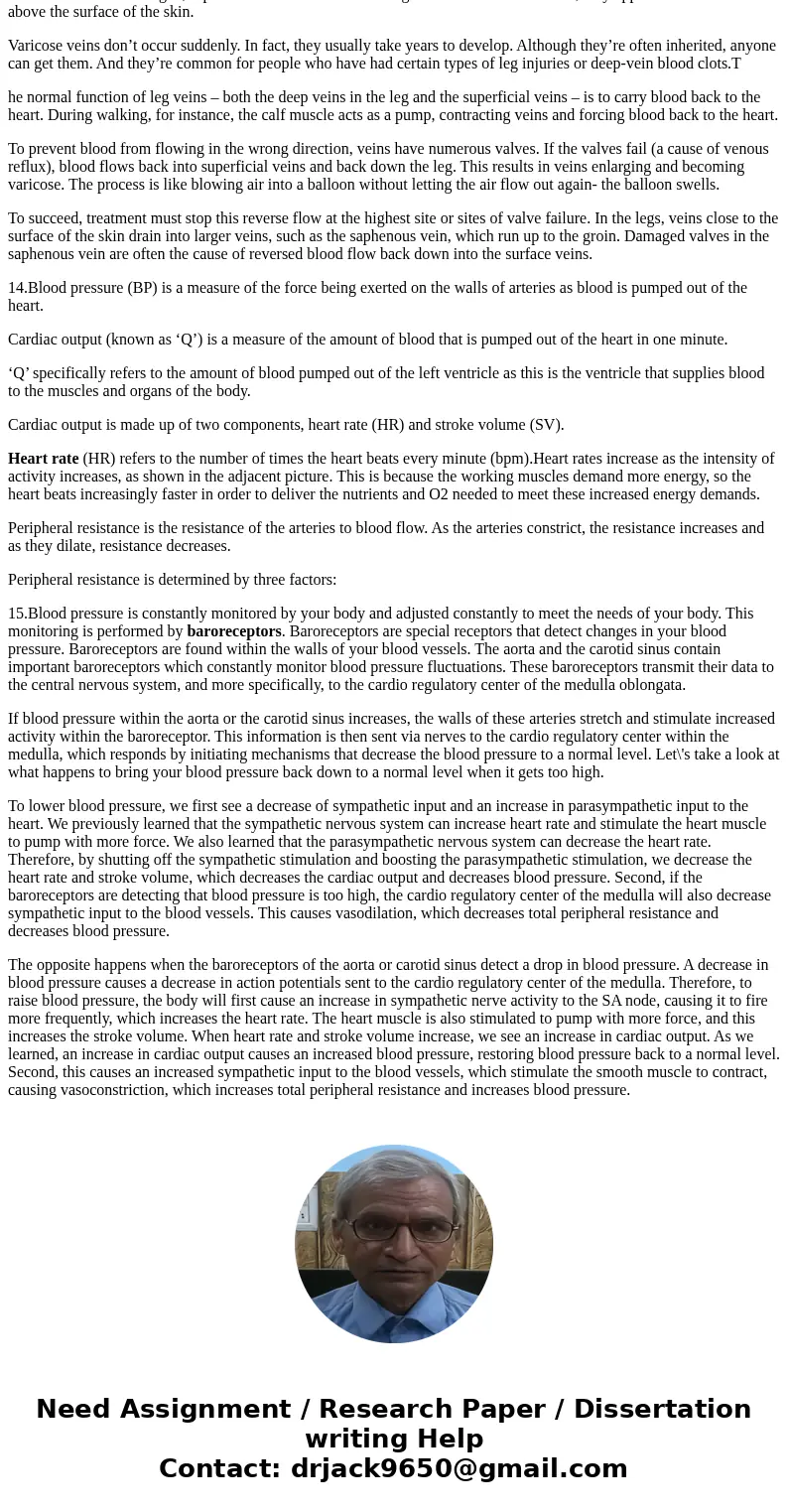What helps move the blood towards the heart in the veins mus
Solution
13.
Blood traveling through the veins has previously passed through the capillaries and lost much of the systolic pressure from the heart that drove it through the thicker, narrower arteries. To keep the venous blood from pooling near the capillaries, or leaching into the space between cells, veins have smooth muscle tissue in their walls that gently contracts to push blood through the circulatory system. The smooth muscles in the walls of the veins manage the contractions, as does all smooth muscle tissue, as the autonomic nervous system is not under conscious control.
Another factor that tends to drive venous blood back into the heart is the contraction of skeletal muscle. The squeezing and flexing of these muscles puts pressure on the blood vessels and locally raises blood pressure enough to push the blood along its path. A series of valves that close in response to back pressure prevents the blood in the veins from flowing backwards.
Varicose veins are enlarged, ropelike veins that occur in the legs. Often dark blue in color, they appear near or raised above the surface of the skin.
Varicose veins don’t occur suddenly. In fact, they usually take years to develop. Although they’re often inherited, anyone can get them. And they’re common for people who have had certain types of leg injuries or deep-vein blood clots.T
he normal function of leg veins – both the deep veins in the leg and the superficial veins – is to carry blood back to the heart. During walking, for instance, the calf muscle acts as a pump, contracting veins and forcing blood back to the heart.
To prevent blood from flowing in the wrong direction, veins have numerous valves. If the valves fail (a cause of venous reflux), blood flows back into superficial veins and back down the leg. This results in veins enlarging and becoming varicose. The process is like blowing air into a balloon without letting the air flow out again- the balloon swells.
To succeed, treatment must stop this reverse flow at the highest site or sites of valve failure. In the legs, veins close to the surface of the skin drain into larger veins, such as the saphenous vein, which run up to the groin. Damaged valves in the saphenous vein are often the cause of reversed blood flow back down into the surface veins.
14.Blood pressure (BP) is a measure of the force being exerted on the walls of arteries as blood is pumped out of the heart.
Cardiac output (known as ‘Q’) is a measure of the amount of blood that is pumped out of the heart in one minute.
‘Q’ specifically refers to the amount of blood pumped out of the left ventricle as this is the ventricle that supplies blood to the muscles and organs of the body.
Cardiac output is made up of two components, heart rate (HR) and stroke volume (SV).
Heart rate (HR) refers to the number of times the heart beats every minute (bpm).Heart rates increase as the intensity of activity increases, as shown in the adjacent picture. This is because the working muscles demand more energy, so the heart beats increasingly faster in order to deliver the nutrients and O2 needed to meet these increased energy demands.
Peripheral resistance is the resistance of the arteries to blood flow. As the arteries constrict, the resistance increases and as they dilate, resistance decreases.
Peripheral resistance is determined by three factors:
15.Blood pressure is constantly monitored by your body and adjusted constantly to meet the needs of your body. This monitoring is performed by baroreceptors. Baroreceptors are special receptors that detect changes in your blood pressure. Baroreceptors are found within the walls of your blood vessels. The aorta and the carotid sinus contain important baroreceptors which constantly monitor blood pressure fluctuations. These baroreceptors transmit their data to the central nervous system, and more specifically, to the cardio regulatory center of the medulla oblongata.
If blood pressure within the aorta or the carotid sinus increases, the walls of these arteries stretch and stimulate increased activity within the baroreceptor. This information is then sent via nerves to the cardio regulatory center within the medulla, which responds by initiating mechanisms that decrease the blood pressure to a normal level. Let\'s take a look at what happens to bring your blood pressure back down to a normal level when it gets too high.
To lower blood pressure, we first see a decrease of sympathetic input and an increase in parasympathetic input to the heart. We previously learned that the sympathetic nervous system can increase heart rate and stimulate the heart muscle to pump with more force. We also learned that the parasympathetic nervous system can decrease the heart rate. Therefore, by shutting off the sympathetic stimulation and boosting the parasympathetic stimulation, we decrease the heart rate and stroke volume, which decreases the cardiac output and decreases blood pressure. Second, if the baroreceptors are detecting that blood pressure is too high, the cardio regulatory center of the medulla will also decrease sympathetic input to the blood vessels. This causes vasodilation, which decreases total peripheral resistance and decreases blood pressure.
The opposite happens when the baroreceptors of the aorta or carotid sinus detect a drop in blood pressure. A decrease in blood pressure causes a decrease in action potentials sent to the cardio regulatory center of the medulla. Therefore, to raise blood pressure, the body will first cause an increase in sympathetic nerve activity to the SA node, causing it to fire more frequently, which increases the heart rate. The heart muscle is also stimulated to pump with more force, and this increases the stroke volume. When heart rate and stroke volume increase, we see an increase in cardiac output. As we learned, an increase in cardiac output causes an increased blood pressure, restoring blood pressure back to a normal level. Second, this causes an increased sympathetic input to the blood vessels, which stimulate the smooth muscle to contract, causing vasoconstriction, which increases total peripheral resistance and increases blood pressure.


 Homework Sourse
Homework Sourse